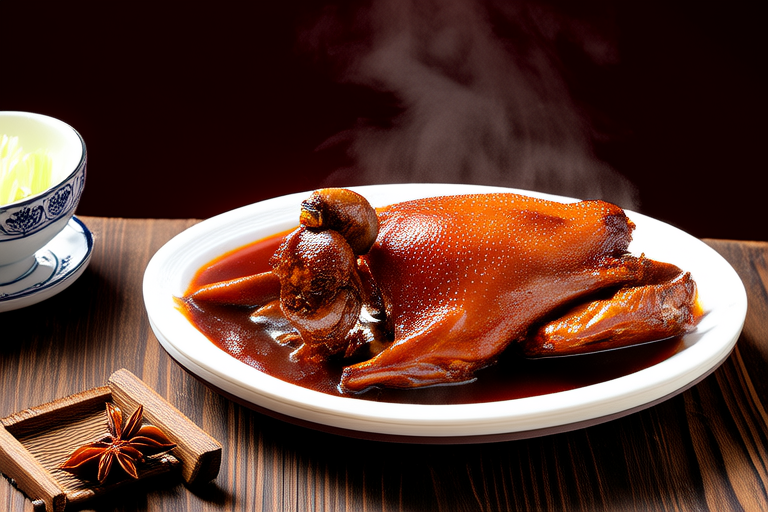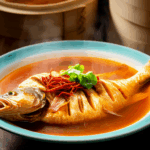Heritage Delight: Minnan Braised Duck in Soy Sauce
Introduction to Minnan Braised Duck in Soy Sauce
The culinary world is rich with traditions that have been passed down through generations. Among these treasures, Minnan Braised Duck in Soy Sauce stands out as a dish that not only tantalizes the taste buds but also carries a profound cultural significance. Originating from the Minnan region of Fujian Province, China, this dish has been a beloved staple for centuries. It is a testament to the ingenuity and creativity of the Minnan people, who have perfected the art of transforming simple ingredients into a symphony of flavors.
Minnan cuisine, known for its emphasis on freshness, simplicity, and balance, is characterized by its use of local ingredients and traditional cooking methods. The Minnan Braised Duck in Soy Sauce exemplifies these principles. The dish combines the richness of duck meat with the umami depth of soy sauce, creating a harmonious blend of textures and flavors. Each bite is a journey through the history and culture of the Minnan region, offering a glimpse into the lives and traditions of its people.
This recipe is not just about following steps; it’s about understanding the cultural and historical context behind each ingredient and technique. By mastering this dish, you’re not only learning how to cook but also preserving a piece of heritage for future generations. Let’s delve into the preparation of this delightful dish and explore the nuances that make it truly special.
Ingredients
To prepare Minnan Braised Duck in Soy Sauce, you will need the following ingredients:
- Duck: Choose a whole duck weighing around 1.5 kg (3.3 lbs). Ensure the duck is fresh and free of any off odors or discoloration.
- Soy Sauce: Use high-quality soy sauce, preferably one with a rich flavor and a deep color. This will be the base of the marinade and the braising liquid.
- Sugar: Granulated sugar is essential for balancing the saltiness of the soy sauce and adding a subtle sweetness to the dish.
- Shaoxing Wine: This rice wine adds an aromatic complexity to the dish, enhancing the overall flavor profile.
- Ginger: Fresh ginger, finely chopped, provides a refreshing and slightly spicy note to the dish.
- Garlic: Crushed garlic cloves add a pungent aroma and a robust flavor.
- Spring Onions: Both the green and white parts of the spring onions are used. They contribute a mild onion flavor and a crisp texture.
- Star Anise: This spice adds a warm, licorice-like flavor that complements the duck perfectly.
- Fennel Seeds: These seeds provide a subtle anise flavor that enhances the overall complexity of the dish.
- Five-Spice Powder: A blend of five spices commonly used in Chinese cuisine, including star anise, fennel seeds, cloves, cinnamon, and Sichuan peppercorns.
- Bamboo Shoots: Fresh bamboo shoots add a crunchy texture and a fresh, earthy flavor to the dish.
- Water Chestnuts: These provide a sweet, nutty flavor and a satisfying crunch.
- Vegetable Oil: For frying and sautéing.
- Salt: To season the duck and adjust the final seasoning of the dish.
Each ingredient plays a crucial role in the final outcome of the dish. The quality of the duck and the freshness of the vegetables are paramount, ensuring that the dish is both flavorful and visually appealing.
Preparation Steps
Step 1: Preparing the Duck
Begin by thoroughly cleaning the duck. Remove any excess fat and pinfeathers, ensuring that the skin is intact. Pat the duck dry with paper towels to remove any moisture. This step is crucial as it helps the skin crisp up during the cooking process.
Next, make several shallow cuts on the skin of the duck, being careful not to cut into the flesh. This will allow the marinade to penetrate deeper into the meat and help the skin crisp up more evenly.
Step 2: Marinating the Duck
In a mixing bowl, combine 1/4 cup of soy sauce, 2 tablespoons of Shaoxing wine, 1 tablespoon of sugar, 1 teaspoon of five-spice powder, and a pinch of salt. Mix well until the sugar and spices are fully dissolved.
Place the cleaned duck in a large bowl or a plastic bag. Pour the marinade over the duck, making sure to coat it evenly. Massage the marinade into the duck, especially focusing on the areas where you made the shallow cuts. Cover the bowl or seal the bag and refrigerate for at least 2 hours, or overnight for the best results. This marination process allows the flavors to penetrate the meat, enhancing its taste and tenderness.
Step 3: Preparing the Vegetables
While the duck is marinating, prepare the vegetables. Peel and slice the bamboo shoots and water chestnuts into thin rounds. Finely chop the ginger and garlic. Cut the spring onions into 2-inch lengths, keeping the green and white parts separate.
Step 4: Frying the Duck
Heat a large skillet or wok over medium-high heat. Add enough vegetable oil to cover the bottom of the pan. Once the oil is hot, carefully place the duck in the pan, skin-side down. Fry the duck for about 10 minutes, turning occasionally to ensure even browning. The goal is to render some of the fat and crisp up the skin. Remove the duck from the pan and set it aside.
Step 5: Sautéing the Vegetables
In the same pan, reduce the heat to medium and add a little more oil if needed. Sauté the chopped ginger and garlic for about 1 minute, until fragrant. Add the sliced bamboo shoots and water chestnuts, stirring frequently. Cook for another 2-3 minutes until they start to soften. Finally, add the white parts of the spring onions and stir-fry for another minute. Remove the vegetables from the pan and set them aside.
Step 6: Braising the Duck
Return the duck to the pan, skin-side up. Add the remaining 1/4 cup of soy sauce, 2 tablespoons of Shaoxing wine, 1 tablespoon of sugar, 1 star anise, and 1 teaspoon of five-spice powder. Pour in enough water to cover the duck halfway. Bring the mixture to a simmer, then reduce the heat to low. Cover the pan and let the duck braise for about 1 hour, or until the meat is tender and falling off the bone.
Step 7: Final Assembly
Once the duck is cooked, remove it from the pan and set it aside to cool slightly. Strain the braising liquid, discarding the solids, and return the liquid to the pan. Bring it to a boil and reduce it by half to concentrate the flavors. Slice the duck into serving pieces, ensuring that each piece includes some skin and meat.
Arrange the duck slices on a platter, garnish with the reserved green parts of the spring onions, and pour the reduced braising liquid over the top. Serve immediately with steamed rice or noodles for a complete meal.
Cooking Techniques and Tips
Cooking Minnan Braised Duck in Soy Sauce requires attention to detail and patience. Here are some tips to ensure the best results:
- Marination Time: Allow the duck to marinate for at least 2 hours, or preferably overnight, to ensure maximum flavor penetration.
- Frying Temperature: When frying the duck, maintain a steady temperature to avoid burning the skin or undercooking the meat. Adjust the heat as necessary.
- Braising Liquid: The braising liquid should cover the duck halfway, but not completely submerge it. This allows the duck to absorb the flavors without becoming overly soggy.
- Vegetable Preparation: The vegetables should be sliced thinly and cooked until just tender. Overcooking can result in a mushy texture.
- Final Reduction: Reducing the braising liquid intensifies the flavors, creating a rich, savory sauce that pairs perfectly with the duck.
By following these techniques and tips, you’ll be able to achieve a dish that is both visually stunning and deliciously satisfying.
Conclusion
Minnan Braised Duck in Soy Sauce is more than just a meal; it’s a celebration of tradition and culinary excellence. Each bite tells a story of generations past, of families gathered around tables, and of the enduring love for food. By preparing this dish, you not only honor the legacy of the Minnan people but also contribute to the preservation of their cultural heritage.
We hope this recipe has inspired you to explore the rich tapestry of Minnan cuisine and to appreciate the artistry involved in crafting such a dish. Happy cooking, and may your table be filled with the joy and warmth that comes from sharing a meal steeped in history and tradition.


